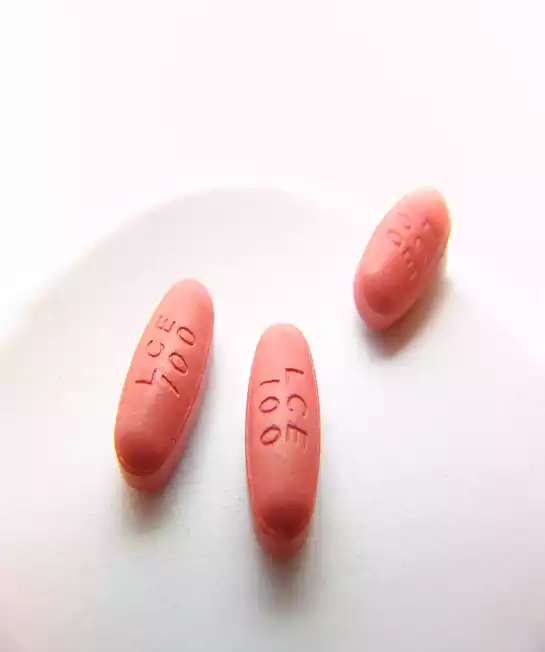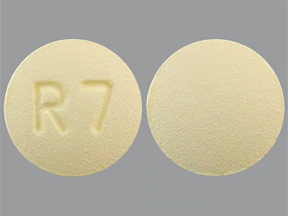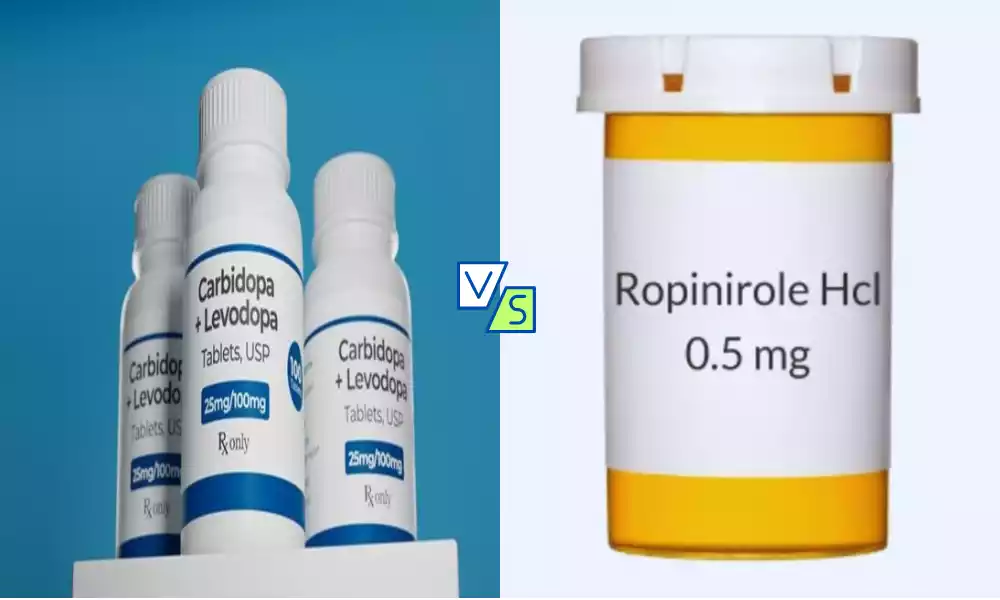Carbidopa-levodopa and Ropinirole are two distinct medications frequently employed in the management of Parkinson’s disease. Carbidopa-levodopa, found in drugs like Sinemet, combines Levodopa, a dopamine precursor, with Carbidopa to enhance its effectiveness. Ropinirole, available as Requip, operates as a dopamine agonist, stimulating dopamine receptors to mitigate PD symptoms. Both medications play pivotal roles in addressing the challenges posed by Parkinson’s disease, albeit through different mechanisms, and understanding their unique attributes is vital for optimizing patient care.
Definition of Carbidopa-Levodopa

Carbidopa-Levodopa is one of the medications frequently used for the treatment of Parkinson’s disease. It is a combination drug that consists of two active ingredients: Levodopa (also known as L-DOPA) and Carbidopa. Levodopa is a precursor to dopamine, a neurotransmitter that is deficient in Parkinson’s disease. Dopamine plays a crucial role in regulating movement and other functions in the brain. Levodopa has limitations when used alone, as a significant amount can be converted into dopamine outside the brain, leading to side effects and reduced efficacy.
Carbidopa is combined with Levodopa to address this issue. Carbidopa inhibits the enzyme that converts Levodopa into dopamine outside the brain, allowing more Levodopa to reach the brain and be converted into dopamine where it is needed. This combination helps to alleviate the motor symptoms of Parkinson’s disease, such as tremors, stiffness, and slowness of movement.
Carbidopa-Levodopa is often marketed under various brand names, with “Sinemet” being one of the most well-known. This medication is a cornerstone of Parkinson’s disease management and has been used for decades to improve the quality of life for individuals living with this condition.
How Does Carbidopa-Levodopa Work?
- Levodopa (L-DOPA):
- Levodopa is a precursor to dopamine, a neurotransmitter in the brain.
- In Parkinson’s disease, dopamine-producing neurons degenerate, leading to motor symptoms.
- Levodopa is administered orally and enters the bloodstream.
- Conversion to Dopamine:
- Levodopa crosses the blood-brain barrier, entering the brain.
- Brain enzymes convert levodopa into dopamine.
- Dopamine Replacement:
- Dopamine is vital for regulating movement and coordination.
- Increasing dopamine levels in the brain compensates for the deficiency in Parkinson’s patients.
- This reduces motor symptoms such as tremors, rigidity, and slowness of movement.
- Role of Carbidopa:
- Carbidopa is combined with levodopa in the medication.
- Its primary function is to prevent the premature breakdown of levodopa in the bloodstream before it reaches the brain.
- This ensures more levodopa reaches the brain intact, where it can be converted into dopamine.
- Carbidopa enhances the therapeutic effect of levodopa while minimizing side effects.
Effectiveness in Symptom Management
Carbidopa-Levodopa and Ropinirole are effective in managing the motor symptoms of Parkinson’s disease, but they achieve this through different mechanisms. The effectiveness of each medication can vary from patient to patient, and the choice between them often depends on individual factors, disease stage, and the presence of other medical conditions.
Here’s a brief overview of the effectiveness of each medication in symptom management:
Carbidopa-Levodopa:
- Carbidopa-Levodopa is considered the most effective symptomatic treatment for Parkinson’s disease, particularly in the early stages and for managing more advanced symptoms.
- Levodopa, the active component, helps replenish the brain’s dopamine levels, leading to significant improvement in motor symptoms such as tremors, rigidity, and bradykinesia.
- It provides rapid and substantial relief from these symptoms, leading to improved mobility and overall quality of life.
- Over time, some patients may experience motor fluctuations and dyskinesias (abnormal involuntary movements) as a result of long-term Levodopa use. This can require adjustments to the treatment regimen.
Ropinirole:
- Ropinirole is a dopamine agonist, which means it directly stimulates dopamine receptors in the brain. It is effective in alleviating motor symptoms similar to Levodopa, though its onset of action may be slightly slower.
- Ropinirole is often used as an initial treatment in early stages of Parkinson’s disease, especially for younger patients who may be at risk for Levodopa-related motor fluctuations.
- It is also used in combination with Levodopa to help manage motor fluctuations and to potentially reduce the overall Levodopa dose, which may help delay the onset of motor complications.
- Ropinirole is also utilized for treating restless legs syndrome (RLS), a condition characterized by uncomfortable sensations in the legs and an urge to move them.
Carbidopa-Levodopa and Ropinirole are effective in managing the motor symptoms of Parkinson’s disease. Carbidopa-Levodopa provides rapid and potent relief, making it a primary choice for symptom management, especially as the disease progresses. Ropinirole, as a dopamine agonist, offers an alternative option, particularly for early-stage patients or those prone to Levodopa-related complications. The choice between the two medications depends on individual patient characteristics and the advice of a healthcare professional.
Dosage and Administration
The dosage and administration of Carbidopa-Levodopa (Sinemet) can vary depending on the specific needs and condition of the patient. It’s essential to follow your healthcare provider’s instructions carefully.
Below is a general guideline, but individual dosing may differ:
Dosage:
-
- Initial Dose: The initial dose typically starts with a low-strength tablet containing a specific ratio of carbidopa to levodopa. Common formulations include 25mg of carbidopa/100mg of levodopa or 10mg of carbidopa/100mg of levodopa. The exact starting dose can vary based on the patient’s age, severity of symptoms, and previous treatment.
- Titration: The dosage is gradually increased under medical supervision until the desired therapeutic effect is achieved. The goal is to find the lowest effective dose that controls symptoms without causing significant side effects.
- Extended-Release Formulations: There are extended-release versions of Carbidopa-Levodopa available. These are taken less frequently throughout the day and can be beneficial for patients who experience fluctuations in symptom control.
Administration:
-
- Timing: Carbidopa-Levodopa is typically taken orally and should be administered as directed by the healthcare provider. It is usually taken multiple times a day to maintain consistent dopamine levels in the brain and manage symptoms effectively.
- Food: Taking the medication with or shortly after a meal that is not high in protein can help improve its absorption. High-protein meals can compete with levodopa for absorption in the small intestine, potentially reducing its effectiveness.
- Consistency: Try to take the medication at the same times each day to maintain a steady level of levodopa in your system.
- Avoid Abrupt Discontinuation: Do not stop taking Carbidopa-Levodopa suddenly without consulting your healthcare provider, as this can lead to a worsening of symptoms.
- Monitoring: Regular follow-up appointments with your healthcare provider are essential to evaluate the medication’s effectiveness and adjust the dosage as needed.
Always consult with your healthcare provider or pharmacist for precise dosing instructions tailored to your specific condition and needs. It’s essential to communicate any side effects or changes in symptoms to your healthcare team to ensure the most effective and safe treatment.
Definition of Ropinirole

Ropinirole is a medication primarily prescribed for the treatment of Parkinson’s disease and restless legs syndrome (RLS). Dopamine antagonist drugs fall under a broad category known as dopamine agonists. In Parkinson’s disease, which is characterized by a deficiency of dopamine in certain parts of the brain, Ropinirole acts by directly stimulating dopamine receptors, mimicking the effects of dopamine.
By activating these receptors, Ropinirole helps alleviate motor symptoms associated with Parkinson’s disease, such as tremors, rigidity, and bradykinesia (slowness of movement). Additionally, Ropinirole is also effective in managing restless legs syndrome, a neurological disorder that causes uncomfortable sensations in the legs, often relieved by movement.
Ropinirole is available in various formulations, including immediate-release and extended-release tablets. This medication’s ability to target specific dopamine receptors offers a different approach to symptom management compared to other Parkinson’s treatments, such as Levodopa. It is important to note that like any medication, Ropinirole may have side effects and interactions, so its use should be closely monitored and discussed with a healthcare professional.
Use in Parkinson’s Disease
Ropinirole is commonly used in the treatment of Parkinson’s disease to alleviate the motor symptoms associated with the condition. Here’s how Ropinirole is used in Parkinson’s disease management:
1. Alleviating Motor Symptoms: Ropinirole, being a dopamine agonist, directly stimulates dopamine receptors in the brain. This stimulation helps compensate for the reduced dopamine levels characteristic of Parkinson’s disease. By activating these receptors, Ropinirole improves the transmission of signals related to movement and motor control. This results in a reduction of motor symptoms such as tremors, rigidity, bradykinesia (slowness of movement), and postural instability.
2. Early-Stage Treatment: Ropinirole is often considered as a treatment option, especially for patients with early-stage Parkinson’s disease. It may be chosen as an initial therapy, particularly for individuals who are relatively young and have a lower risk of developing complications associated with long-term Levodopa use.
3. Monotherapy or Combination Therapy: Ropinirole can be used as monotherapy, meaning it’s the sole medication prescribed to manage Parkinson’s symptoms. It can also be used in combination with other medications like Levodopa to enhance symptom control. When combined with Levodopa, Ropinirole can help mitigate motor fluctuations and potentially delay the onset of Levodopa-related dyskinesias (abnormal involuntary movements).
4. Tailoring Treatment: The choice of using Ropinirole or other medications depends on factors such as the patient’s age, disease progression, symptom severity, and individual response to the medication. Healthcare providers often customize treatment plans to address the unique needs and preferences of each patient.
5. Dosage and Titration: Ropinirole is typically started at a low dose and gradually titrated upward over time to achieve optimal symptom relief while minimizing side effects. The exact dosage and titration schedule are determined by the healthcare provider based on the patient’s response.
6. Monitoring and Adjustments: Regular monitoring of symptoms and potential side effects is essential when using Ropinirole or any Parkinson’s disease medication. Dosage adjustments may be necessary as the disease progresses and as the patient’s needs change.
7. Considerations: While Ropinirole can effectively manage motor symptoms, it may also have side effects, including nausea, dizziness, and potential compulsive behaviors. These aspects should be discussed with the healthcare provider before starting treatment.
It’s important to note that treatment decisions should always be made in consultation with a healthcare professional who can assess the patient’s individual condition and recommend the most appropriate course of action.
Dosage Considerations of Ropinirole
Dosage considerations for Ropinirole, a dopamine agonist used in the treatment of Parkinson’s disease and restless legs syndrome, are important for achieving optimal therapeutic effects while minimizing potential side effects. Dosage decisions should be made in consultation with a healthcare provider who can assess the patient’s individual condition and response to the medication.
Here are key dosage considerations for Ropinirole:
-
- Initial Dosage: The initial dosage of Ropinirole is typically low to minimize the risk of side effects. It is gradually titrated upward over a period of several weeks to reach the effective dose for symptom management.
- Immediate-Release vs. Extended-Release: Ropinirole is available in both immediate-release (IR) and extended-release (ER) formulations. The choice of formulation affects dosing frequency and titration schedule. Extended-release formulations are usually taken once daily and have a different titration pattern compared to immediate-release forms.
- Dosing Frequency (IR Formulation): For immediate-release Ropinirole, the total daily dose is divided into multiple administrations, usually taken three times daily. This helps maintain consistent therapeutic levels in the bloodstream.
- Titration Schedule: The titration schedule varies based on the formulation being used. Healthcare providers follow a predetermined schedule to gradually increase the dosage, allowing the patient’s body to adjust and minimize side effects.
- Individualized Treatment: Dosage adjustments are personalized based on the patient’s response, severity of symptoms, age, and overall health. Aiming to find an optimal dose that efficiently alleviates symptoms while simultaneously limiting any negative side-effects is of utmost importance.
- Combination Therapy: Ropinirole can be used as monotherapy or in combination with other medications, such as Levodopa. When used in combination, dosages of both Ropinirole and other medications may need to be adjusted to achieve optimal symptom control.
- Monitoring for Side Effects: Healthcare providers closely monitor patients for potential side effects, such as nausea, dizziness, and somnolence. If these side effects occur, dosage adjustments may be necessary.
- Disease Progression: As Parkinson’s disease progresses, the patient’s symptoms and needs may change. Regular re-evaluation of the dosage and treatment plan is essential to ensure ongoing effectiveness.
- Restless Legs Syndrome (RLS): For RLS, Ropinirole is typically administered once daily in the evening, about 1 to 3 hours before bedtime, as symptoms are most prominent at night. The dosage is adjusted based on symptom response.
- Regular Follow-Up: Patients should have regular follow-up appointments with their healthcare provider to assess treatment effectiveness, make necessary dosage adjustments, and address any concerns.
It’s important to remember that each patient’s response to Ropinirole can vary. Healthcare providers take into account various factors when determining the appropriate dosage, and communication between the patient and their healthcare team is essential for achieving the best possible treatment outcomes.
Comparison Table of Carbidopa-Levodopa and Ropinirole
Here’s a comparison table outlining key differences between Carbidopa-Levodopa and Ropinirole in the treatment of Parkinson’s disease:
| Aspect | Carbidopa-Levodopa | Ropinirole |
|---|---|---|
| Mechanism of Action | Levodopa precursor to dopamine; Carbidopa enhances Levodopa’s effectiveness | Dopamine agonist; stimulates dopamine receptors directly |
| Primary Use | Symptomatic relief of motor symptoms of Parkinson’s disease | Symptomatic relief of motor symptoms of Parkinson’s disease and restless legs syndrome |
| Treatment Stage | Used throughout all stages of Parkinson’s disease | Commonly used in early stages and as an adjunct to Levodopa in later stages |
| Administration | Immediate-release and extended-release tablets | Immediate-release and extended-release tablets |
| Dosage Frequency | Multiple times per day | Once or multiple times per day |
| Side Effects | Motor fluctuations, dyskinesias, nausea, hallucinations | Nausea, dizziness, daytime sleepiness, impulse control disorders |
| Onset of Action | Rapid onset, providing quick symptom relief | Gradual onset, may take time to achieve optimal symptom control |
| Combination Therapy | Often used in combination with other medications | Can be used as monotherapy or in combination with other medications |
| Motor Fluctuations | Can lead to “on-off” fluctuations over time | May help mitigate motor fluctuations when used in combination with Levodopa |
| Tolerance and Long-Term Use | May develop motor complications over time | Potential for developing motor complications with prolonged use |
| Dosage Adjustments | Adjusted to manage motor fluctuations and side effects | Gradually titrated to find optimal symptom relief while minimizing side effects |
| Dopamine Receptor Activation | Increases brain dopamine levels by providing Levodopa | Directly stimulates dopamine receptors in the brain |
| Suitable for Early Stages | Yes | Yes, particularly for those with lower risk of complications |
| Management of Restless Legs Syndrome (RLS) | Not typically used for RLS | Effective treatment option for RLS |
| Monitoring | Regular monitoring of motor symptoms and complications | Regular monitoring for symptom relief and side effects |
Remember that treatment decisions should be made in consultation with a healthcare provider, considering the individual patient’s condition, medical history, and preferences. This table provides a simplified overview and doesn’t cover all possible considerations.
Side Effects and Management
Carbidopa-Levodopa and Ropinirole can cause side effects, although the specific side effects and their severity can vary from person to person. It’s important for patients and healthcare providers to be aware of potential side effects and to work together to manage them effectively.
Here are some common side effects associated with each medication and how they might be managed:
Side Effects of Carbidopa-Levodopa:
- Nausea and Vomiting: Nausea and vomiting are common side effects, especially when starting Carbidopa-Levodopa. Taking the medication with a light meal or snack can help reduce these symptoms. In some cases, the healthcare provider might prescribe an anti-nausea medication.
- Fluctuations in Motor Response: Over time, some patients may experience motor fluctuations, where the effectiveness of Carbidopa-Levodopa fluctuates between periods of improved mobility (on periods) and reduced effectiveness (off periods). Adjusting the dosage or changing the medication regimen can help manage these fluctuations.
- Dyskinesias: Dyskinesias are involuntary, jerky movements that can develop after prolonged use of Carbidopa-Levodopa. Dosage adjustments or changes in the treatment regimen might be necessary to manage dyskinesias.
- Hallucinations and Psychiatric Symptoms: In some cases, Carbidopa-Levodopa can cause hallucinations or other psychiatric symptoms. These should be reported to the healthcare provider, who can adjust the medication or recommend additional treatments.
Side Effects of Ropinirole:
- Nausea and Dizziness: Nausea and dizziness are common side effects when starting Ropinirole. Combining medication and food may help ease symptoms. Starting with a low dose and gradually increasing it can also help reduce the likelihood of these side effects.
- Daytime Sleepiness: Ropinirole can cause excessive daytime sleepiness in some individuals. Patients taking antipsychotics must monitor how the medication affects them closely until they understand its full impact.
- Impulse Control Disorders: Ropinirole and other dopamine agonists have been associated with impulse control disorders, such as gambling, hypersexuality, and excessive shopping. Patients and caregivers should be vigilant for changes in behavior and report them to the healthcare provider.
- Orthostatic Hypotension: Ropinirole can cause a drop in blood pressure upon standing, leading to dizziness or fainting. Rising slowly from a sitting or lying position can help minimize this effect.
Managing Side Effects:
- Communication: Open communication between patients and healthcare providers is crucial. Patients should report any new or unusual symptoms to their healthcare team.
- Dosage Adjustments: If side effects are bothersome, the healthcare provider may adjust the dosage, change the medication regimen, or recommend different formulations.
- Gradual Titration: Starting with a low dose and gradually titrating upward can help the body adjust to the medication and reduce the risk of certain side effects.
- Medication Timing: Taking medication with or without food, at specific times of day, or in certain formulations can influence side effects. Healthcare providers can provide guidance on optimal timing.
- Monitoring: Regular follow-up appointments with the healthcare provider allow for ongoing monitoring of side effects and adjustments to the treatment plan.
It’s important for patients not to discontinue or adjust their medication regimen without consulting their healthcare provider, even if they experience side effects. Healthcare providers can work with patients to find the most suitable treatment approach that balances symptom relief and side effect management.
Choosing Between Carbidopa-Levodopa and Ropinirole

Choosing between Carbidopa-Levodopa and Ropinirole for the treatment of Parkinson’s disease involves considering various factors, including disease characteristics, patient preferences, and potential risks and benefits. Here’s a structured approach to help guide the decision-making process:
1. Disease Stage:
- Consider the current stage of Parkinson’s disease. Carbidopa-Levodopa is effective throughout all stages, while Ropinirole is often used in the early stages to delay Levodopa-related complications.
2. Symptom Severity:
- Assess the severity of motor symptoms. Carbidopa-Levodopa provides rapid and potent relief, making it suitable for moderate to severe symptoms. Ropinirole is considered for mild to moderate symptoms.
3. Age and Risk Profile:
- Evaluate the patient’s age and risk profile for complications. Ropinirole might be preferred for younger patients at lower risk of motor fluctuations and dyskinesias.
4. Treatment Goals:
- Define the treatment goals. Carbidopa-Levodopa offers strong and quick symptom relief, while Ropinirole may suit those who prefer a dopamine agonist or seek an alternative to Levodopa.
5. Side Effects and Tolerance:
- Consider potential side effects and the patient’s tolerance. Ropinirole can cause nausea, dizziness, and daytime sleepiness initially, while Carbidopa-Levodopa might lead to motor fluctuations and dyskinesias.
6. Combination Therapy:
- Determine if combination therapy is needed. Carbidopa-Levodopa can be combined with other medications to manage motor fluctuations. Ropinirole can also be used in combination with Levodopa.
7. Restless Legs Syndrome (RLS):
- Assess if the patient also has restless legs syndrome. Ropinirole can effectively treat both Parkinson’s disease and RLS.
8. Patient Preferences:
- Involve the patient in the decision-making process. Discuss preferences, lifestyle, and any concerns they might have.
9. Healthcare Provider Expertise:
- Seek guidance from a healthcare provider experienced in Parkinson’s disease management to make an informed decision.
10. Individual Response:
- Remember that individual responses to medications vary. What works well for one patient may not be the best choice for another.
11. Trial Period:
- Consider starting with the chosen medication under the guidance of a healthcare provider and closely monitoring the patient’s response over a defined trial period.
12. Ongoing Monitoring:
- Regularly assess treatment effectiveness and potential side effects. Prepare to adjust your treatment plan as required.
The decision between Carbidopa-Levodopa and Ropinirole should be based on a comprehensive assessment of the patient’s specific circumstances. Consultation with a healthcare provider who understands the nuances of Parkinson’s disease treatment is essential. Open communication, informed discussions, and a collaborative approach are key to finding the most suitable treatment strategy for each individual.
Summary
Carbidopa-Levodopa and Ropinirole are two stalwarts in the treatment of Parkinson’s disease. They offer hope and relief to patients grappling with the challenges of this neurological condition. While these medications are not without side effects, the benefits they provide in terms of symptom management are invaluable.
By working closely with healthcare providers, making lifestyle modifications, and adhering to treatment plans, individuals with Parkinson’s can lead fulfilling lives despite the challenges they face.



